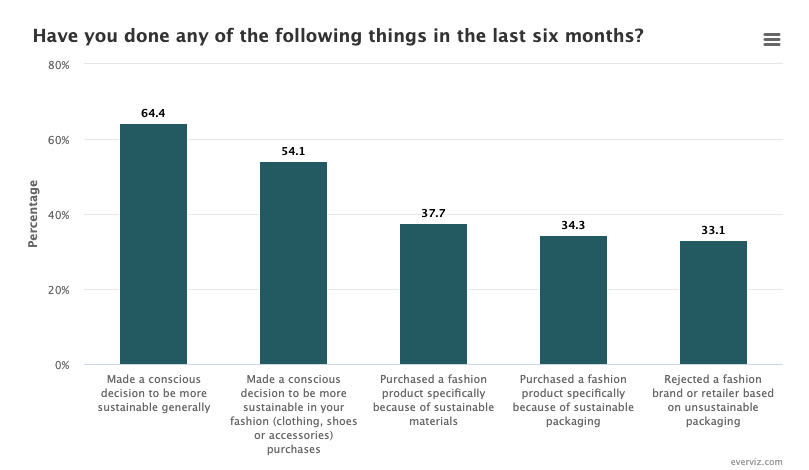Retailers are increasingly looking for new ways to make their operations more environmentally friendly, and RFID for sustainable fashion retail is one of the solutions.
Is RFID The Key to Sustainable Fashion Retail?

Sustainability is a buzzword in the fashion industry and has been for many years. As the world looks for ways to slow the extent of climate change, retail is an important beacon for change.
The Intergovernmental Panel on Climate Change’s (IPCC) most recent report makes for uncomfortable reading. The panel predicts that global warming will reach 1.5 degrees Celsius by the early 2030s, resulting in unprecedented ice melt, seawater rising, and extreme heatwaves. However, there is also hope that reducing emissions and global consumption could halt rising temperatures, enabling the world to meet the goals of the Paris Agreement.
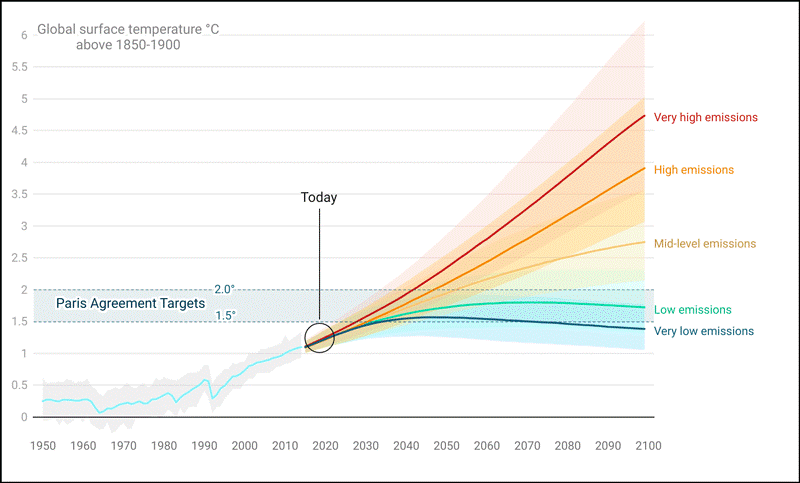
One industry that requires urgent change is fashion retail. The fashion industry alone accounts for as much as 10% of global greenhouse gas emissions as well as 20% of wastewater. Additionally, 85% of the world’s textiles end their life in landfills or incinerators.
Many retailers are already doing what they can to make their operations more sustainable. This includes investing in sustainable materials as well as making physical stores more environmentally friendly. However, consumers are demanding more. This requires new innovations, and RFID for sustainable fashion retail could prove to be the solution.
Many retailers already understand the value offered by RFID in improving the efficiency of operations and omnichannel retailing, but are less aware of the applications of RFID for sustainable fashion retail. However, the technology is crucial if retailers are to make their supply chains more environmentally friendly.
The Emergence of Sustainability in Fashion Retail
Fashion retail sustainability is not a new trend, but it’s certainly true that the move towards more environmentally-friendly fashion has sped up in the last few years. This has been exacerbated both by consumer trends and the damning evidence coming out of research from organisations like the IPCC.
At the G7 summit in August 2020, 32 fashion companies pledged to make their businesses more sustainable. This includes cutting out the use of single-use plastic by 2030 and seeking out environmentally-friendly raw materials. Luxury fashion, meanwhile, is aiming for net-zero emissions by 2050.
In luxury fashion, Chloé is going further. In October 2021, they became the first luxury fashion brand to receive B-Corp certification, a testament to their commitment to the ‘triple bottom line’. With their latest footwear line, they used 58% lower-impact materials, compared to 40% for their autumn/winter 2021 collection.
It’s not just a desire to help the planet that is driving fashion retailers to commit to sustainability initiatives, though. Consumer behaviour is also changing. Today, 66% of people say sustainability is a key factor when they make a purchase. The figure is even higher for the younger, millennial age group, at 75%.
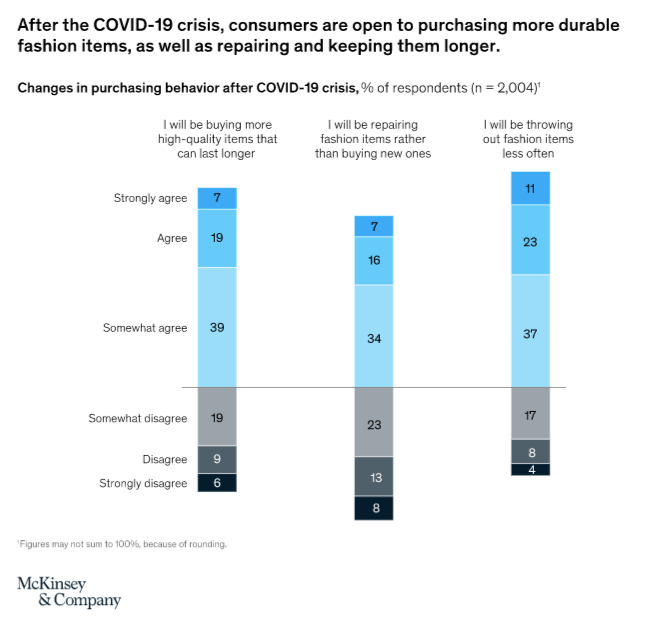
There’s even more evidence of how consumer demand is changing. The Sustainability and the Consumer Report from 2021 by Drapers examined how consumers in the UK are reacting to sustainable fashion retail.
The study found that, between January and July 2021, 64% of consumers had made a conscious decision to be more sustainable, and 54% of consumers chose to be more sustainable with their fashion retail choices specifically. Overall, one-quarter of consumers say they think about sustainability all the time when making purchasing decisions.
Changing consumer behaviour is evidently driving fashion to be more sustainable. In fact, 50% of C-suite executives in fashion and textiles say that consumer demand is affecting their approach to sustainability. For many brands, responding to consumer demands might mean establishing carbon offsetting or making biodegradable packaging. But committing to fashion retail sustainability will require more than this.
The Problem of the Supply Chain
Fashion supply chains are endlessly complex. Globalisation and cost pressures have ensured that few fashion brands actually have an end-to-end view of their entire supply chain. However, the key to fashion retail sustainability actually lies in the supply chain.
Retail brand Patagonia have stated that 95% of their total carbon emissions come from their supply chain. A staggering 86% of this figure is solely from the creation of the materials necessary for production. Overall, retail supply chain emissions are 28 times as high as operational emissions. However, emissions created in other areas of the supply chain–for example, getting products from production to stores–is not to be underestimated.
For retail brands, cutting emissions within their own operations–distinct from the process of creating raw materials–could deliver 20% of total reductions in carbon emissions. A more efficient approach to transport, retail, and packaging could deliver a saving of 308 million tonnes of CO2 by 2030.
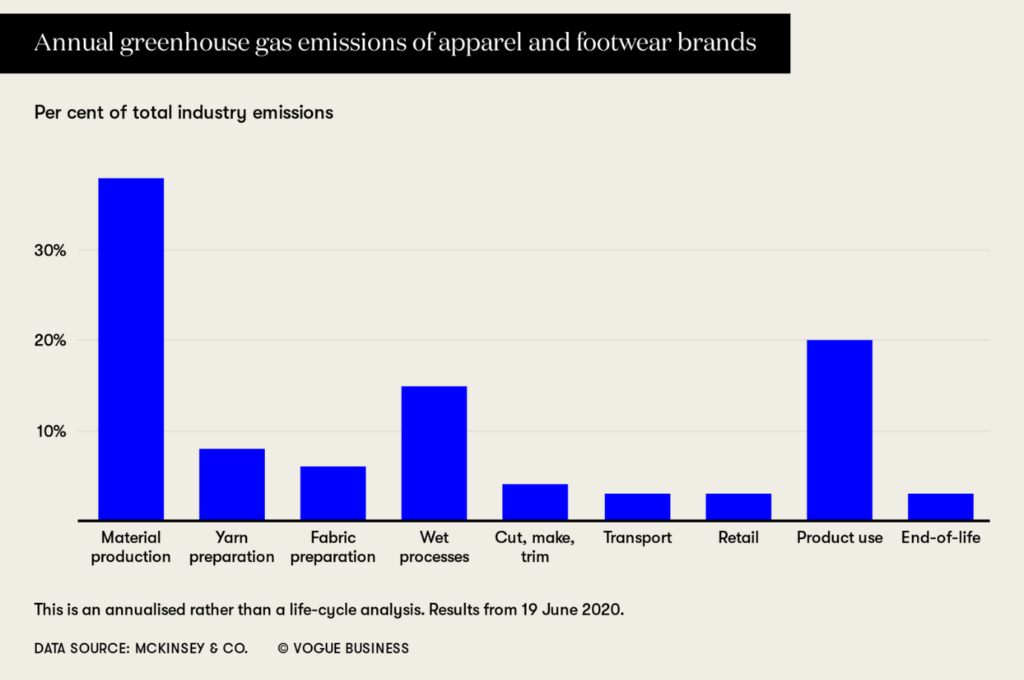
Not only is there a consumer demand for change across the supply chain–and for companies to be able to articulate that change and take control of their entire operations–but there could be financial risks to not adapting. Companies will face up to $120 billion in costs from environmental risks in their supply chain by 2026 due to physical impacts like floods and the increased cost of raw materials due to climate change.
Aside from supply, there are other areas within fashion retailing that will require an overhaul to be more sustainable. One of these is reducing waste. While part of the responsibility for reducing waste lies with the consumer (12% of people aged 18-24 buy fashion once a week, and 11% say they bin clothing they don’t want anymore), fashion retailers can also do more on their side. For example, every season, about 30% of clothes that are made are never sold. Improved operations and logistics–and utilising data to understand consumer trends–could help reduce the amount of clothes that go unused.
Similarly, fashion retailers can invest in circular modes of production and selling, whereby clothes can be returned to a company at the end of their life. Drop-off boxes for recycling clothes are already a staple in some stores, and all go towards improving the sustainability of fashion retail.
While there are a number of ways retailers can improve their sustainability, many companies are simply not ready to make the changes. In order to reduce their environmental impact, companies should be embracing technological innovations such as enhanced data gathering, digitised supply chains, and RFID for retail.
Turning to Technology to Solve Sustainability Issues
Today, 95% of retail CEOs say they plan to increase their investment in digital solutions, evidence that the entire industry sees the value in digital innovation. And while technology has evidently contributed to more emissions by making clothes cheaper and faster to produce, technology like RFID for sustainable fashion retail can also be a way to solve many of the industry’s environmental problems.
One of the biggest problems in the retail supply chain is a lack of visibility. As consumers increasingly demand information on the sustainability of retail operations, retailers will need to turn to new ways of obtaining that data.
Not only does digitising of supply chains increase efficiency and transparency (both of which are important when reducing overall environmental impact), but it also offers retailers in-depth data into their supply chain. More data equals more accountability–it’s a way for retailers to show consumers that they are actively working towards sustainability in their operations.
Retailers that are concerned about the cost of introducing digital innovations in their supply chain needn’t worry. Research shows that around 90% of actions necessary to reduce overall environmental impact can be delivered for a cost below $50 per tonne of CO2. In the end, companies that work towards digitising their supply chains save up to 50% on their costs: and that’s not counting the drastic sustainability benefits.
Additionally, the cost of innovations like RFID for retail has been steadily falling over the last ten years to 80% of its original cost. This is crucial, as RFID could be the solution for sustainable fashion retail.
How RFID Can Benefit Sustainable Fashion Retail
RFID has huge benefits for retail. Not only can the technology support omnichannel retailing but also make supply chains more efficient and help improve the customer experience. Overall, retailers–especially in the fashion industry–are increasingly turning to RFID to solve retail problems.
93% of retailers in the US already use RFID, up from just 34% in 2014. Additionally, 22% of softlines retailers have plans to adopt RFID in order to support supply chain and analytics. Despite this, though, many are still unaware of the value of RFID for sustainable fashion retail.
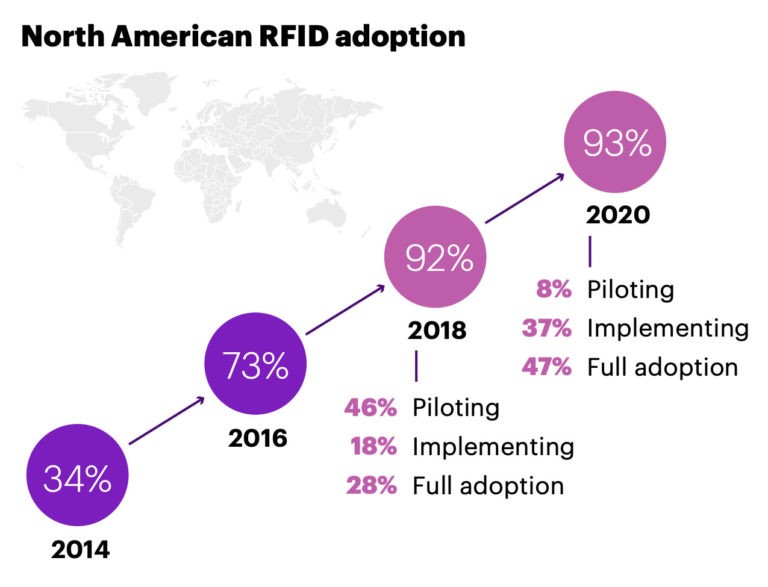
When it comes to making fashion more sustainable, two things are vitally important: data and traceability. As we’ve explored, without end-to-end visibility, it’s impossible for retailers to understand the environmental risks in their supply chain. Furthermore, without data, retailers cannot be transparent and will lack the understanding to make changes to their supply chains to make them more sustainable.
The solution to both of these problems is RFID for retail. When retailers embrace RFID for sustainable fashion retail, they take the first step toward more environmentally-friendly business practices.
Reduce and Reuse Applications
With millions of items sent to landfill every year, retailers need to find a solution to the problem of retail waste. When RFID is used for sustainable fashion retail, it can help retailers find ways to reuse stock and reduce the raw materials required for creating products.
For example, RFID can show retailers which products are and aren’t selling in real-time, allowing retailers to make immediate decisions to improve sustainability. They could make adjustments to stock at the initial manufacturing stage, minimising their use of materials.
Additionally, RFID also has applications for sustainable fashion retail in promoting a circular fashion economy by allowing garments to be returned to retailers at the end of their life. RFID could allow reuse and recycling applications for old stock by tracking exactly where stock is and allowing for more accurate sorting of old stock in preparation for recycling.
Smart Inventory Management
Using RFID tags in retail results in a 25% improvement in inventory accuracy. With Detego’s end-to-end RFID software, retailers can achieve 99% total inventory accuracy. This is crucial for fashion retail sustainability, as more efficient inventory logistics means less waste along the supply chain and in stores.
With RFID for sustainable fashion retail, stores can trust that they are only ordering what they need, and they have the ability to quickly react to consumer trends, producing only what will eventually sell. This prevents overstocking and makes transportation more efficient.
Optimising Retail Space
We know that e-commerce is more sustainable than physical retailing. In fact, on average, shopping online emits three times less CO2 than visiting a real-life store. However, brick-and-mortar stores are clearly here to stay.
Research from Deloitte found that more consumers are embracing omnichannel shopping–a mix of physical and online–rather than solely e-commerce. In fact, 27% of online retail purchases are fulfilled at a physical location.
As the need for a mix of physical stores and online shopping becomes more apparent, retailers will have to think carefully about how to improve the sustainability of their stores. RFID for sustainable fashion retail offers a way to do this–by optimising retail space by only selling the items that are in demand at that particular time.
End-to-End Traceability
We already know that without end-to-end visibility, retailers cannot begin to create a sustainability strategy. The technology grants retailers full visibility of their operations, as stock makes its way from warehouses to distribution centres or stores.
By harnessing the data created by RFID tags, retailers can begin to publish information about their sustainability strategy. Not only will this inform future sustainability actions by letting retailers know which policies are performing, but it also lets consumers know that you’re taking action against climate change. As such, RFID for sustainable fashion retail has multiple benefits: it makes retailers more sustainable and improves customer interactions with your brand.

An RFID retail solution
Stock accuracy, on-floor availability, and RFID omnichannel applications in stores.
Book an RFID demo to find out how our cloud-hosted RFID for retail solution could help you improve your sustainable credentials. Our multi-user app can provide intelligent stock takes and a smart in-store replenishment process, making your retail strategy more sustainable. With RFID for sustainable fashion retail, you get end-to-end visibility of your supply chain, making it easier to make changes to be more environmentally friendly.

